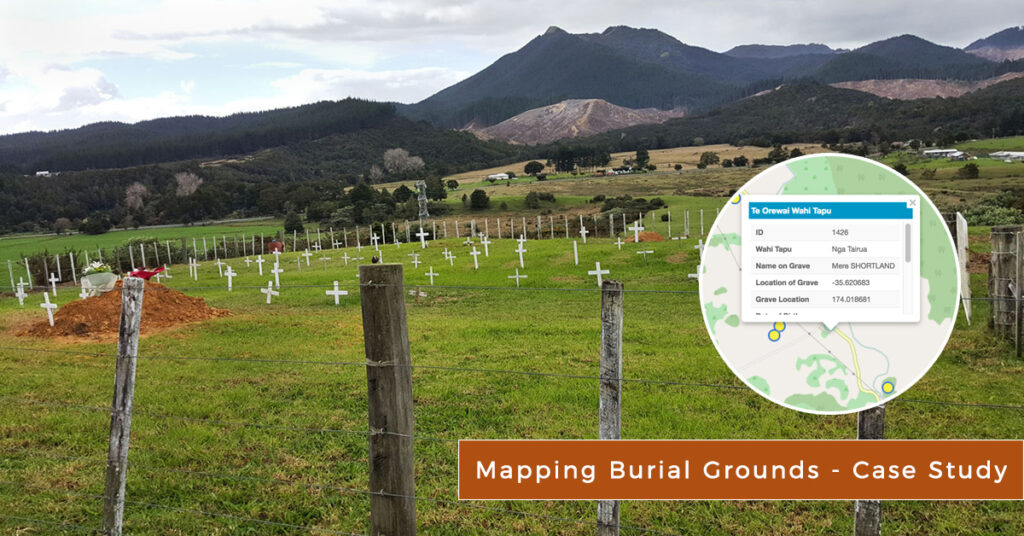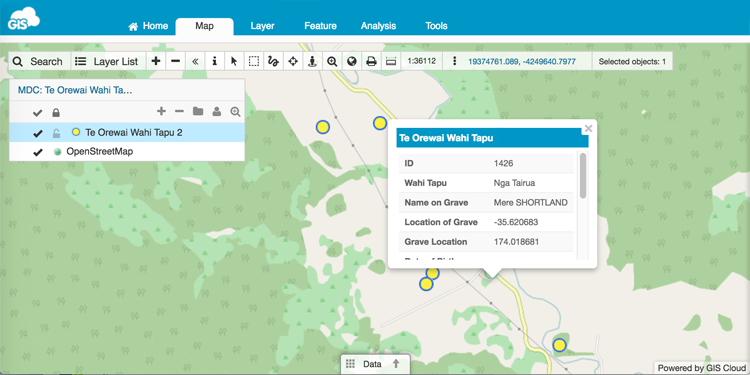In the digital age, many cultural practices important for local communities are facing the threat of being forgotten. One of our most inspiring user stories, demonstrating the great potential of GIS Cloud mapping technologies, comes from Pipiwai, Northland (New Zealand).
Delaraine Armstrong, Betty Cherrington, and Margaret Tipene, who won the 2nd prize in the 2015 GIS Day Contest, mapped 4 tribal burial grounds with a goal to permanently digitally record each grave marker, location, and name, to preserve burial places of their ancestors. Anyone in search of their ancestors will be able to locate their resting place on an interactive map.
This project is designed to preserve important cultural practices and knowledge for the Te Orewai, Maori subtribe located at the foot of the Motatau mountain.
Read their story, together with a follow-up on the project’s development.
Cemetery Tombstones and The Importance of Humility
Delaraine Armstrong begins with a story about Maori culture and their heritage, shaped around deeply rooted awareness of the land and location. The burial practices play an important role in uniting their local community.
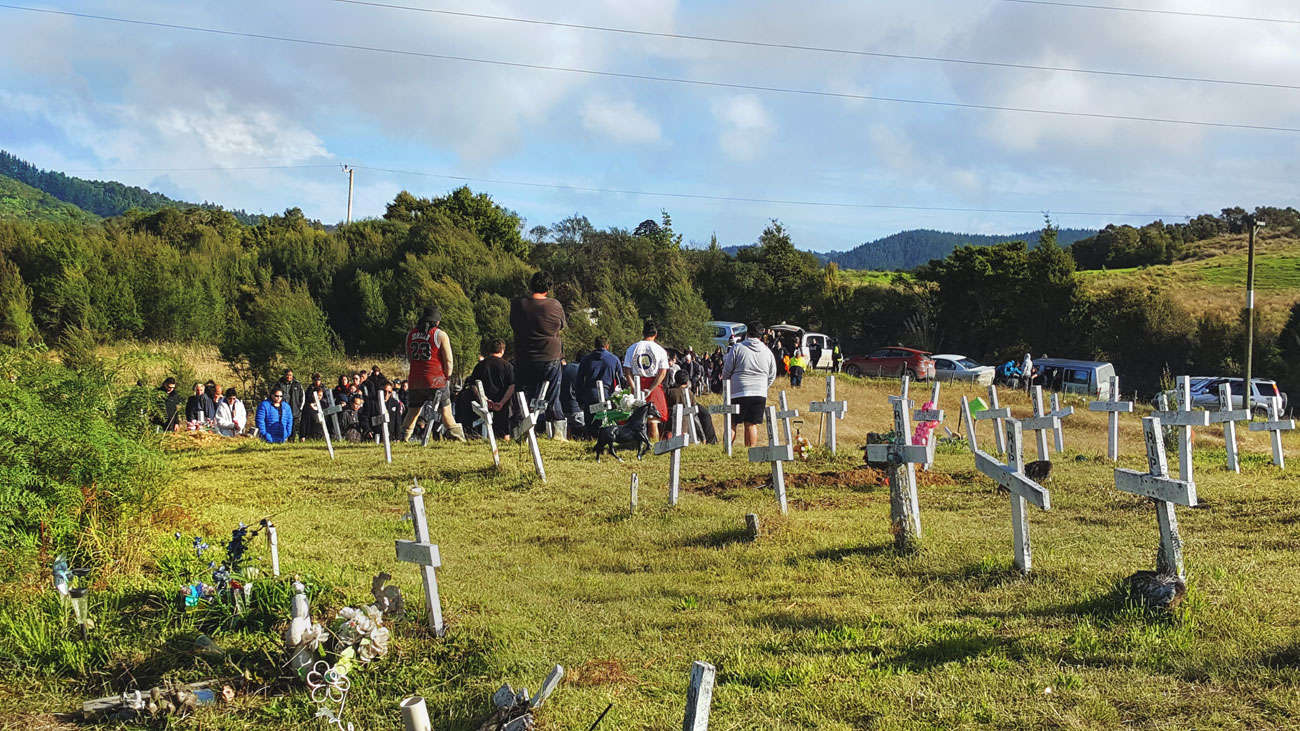
An example of the traditional Te Orewai burial ground (wahi tapu)
In our Maori culture, we are very connected to the land. The mountains and rivers are personified ancestors for Maori. The picture shows the Hoterene whanau (Shortland family) cemetery of small white crosses, which has been the burial place of the Hoterene whanau for the last 150 years, and the mountain behind is our ancestral mountain, Motatau.
There is a story told amongst our large whanau (family) about why there are only small white wooden crosses in this wahi tapu (cemetery). We are told that our key progenitor, Ganny Heeni, decided that after her parents were buried there, everyone who was buried afterwards would only have small white wooden crosses on their graves. Humility was an important value to this great dowager ancestor.
For the members of Te Orewai, this meant that all grave markers in their burial grounds should stay the same so that everyone would be equal. This also applies to flowers that are left on the graves. If somebody places a flower on a grave of his/her ancestor, they should also place a flower on all other graves in the wahi tapu. According to Delaraine, this very tradition is what binds them together as one large whanau (extended family).
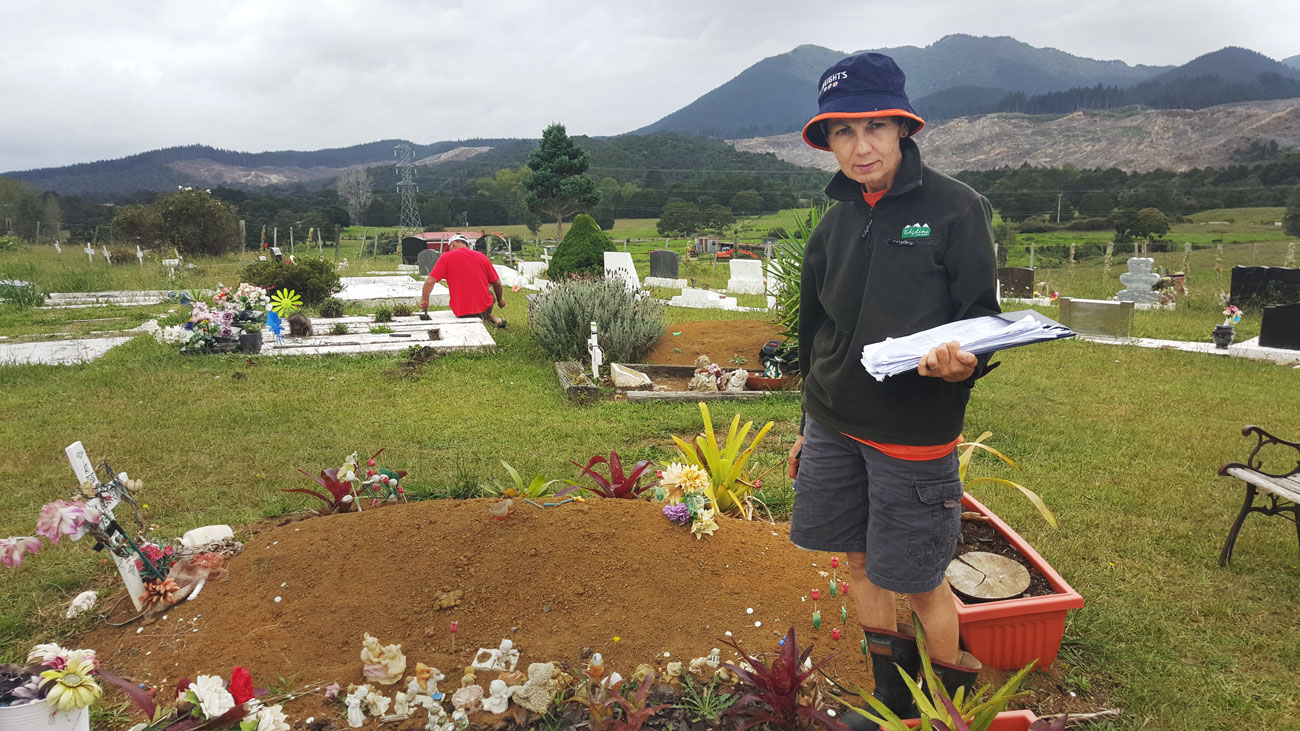
Collecting records in the field
Burial Practices Preserve Maori Culture and Language
Delaraine describes the cultural meaning of the burial practices in the historical context:
Until Europeans came to Aotearoa in the mid-1800’s, we had different cultural burial practices. While the bodies are now interred differently than in the past, we retain our tangihanga (the unique practice of mourning and receiving mourners who come to pay respects over the 3 days after death, to acknowledge the deceased and the whanau pani– grieving family of the deceased in our marae).
She describes marae as the “long house” equivalent for Wahi Tapu – the central place where clans and tribes gather for a different family, community and tribal events and practices. They serve as the physical manifestation of their cultural identity and connections to their ancestral lands. Delaraine states that the Maori language is spoken during these practices, following specific cultural protocols. Those protocols anchor the community to their culture. At the same time, they also serve as a way to distinguish their community in its uniqueness.
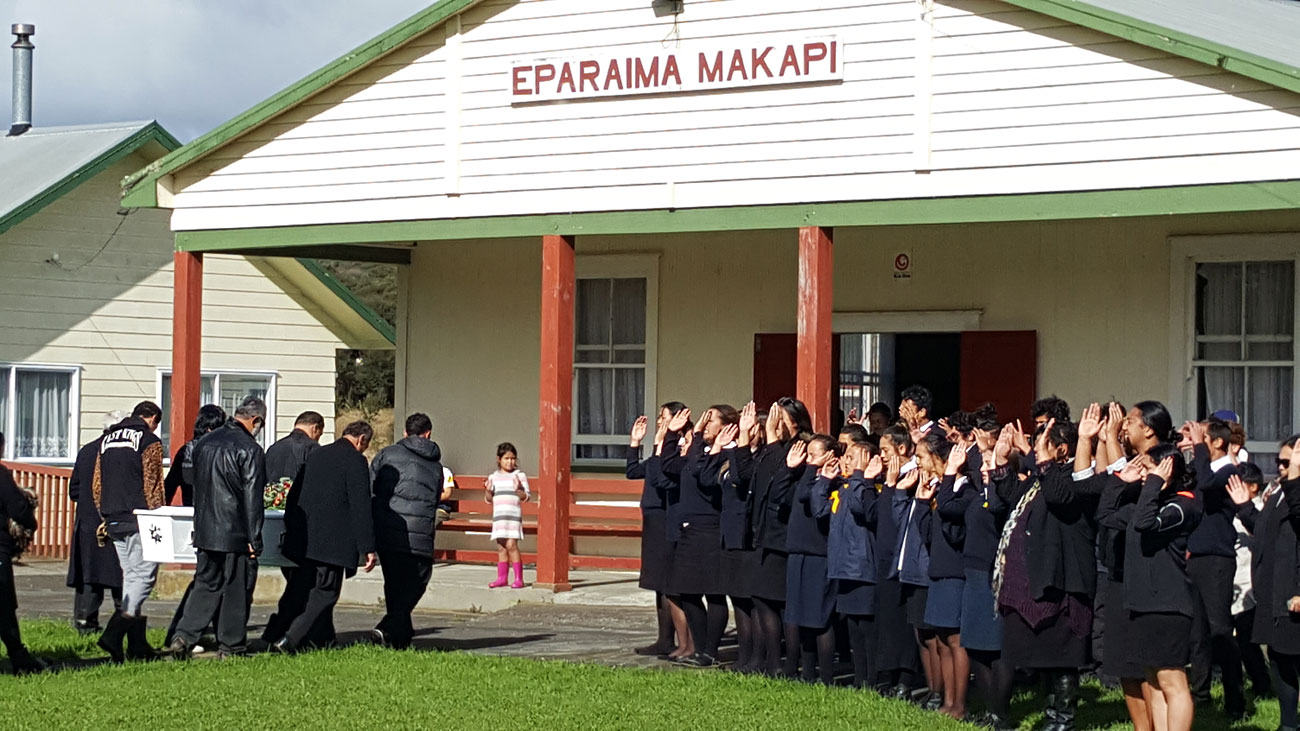
An example of the Te Orewai burial service and marae (‘long house’)
For all of these reasons, burial practices play an important role in preserving the Maori culture and language. Apart from the events following the burial of the deceased, memory of the past ancestors is an important identifier bearing a deep meaning in relation to different Maori subtribes.
For Delaraine, cultural connections and future identity as a hapu (subtribe) and tribe are the reasons why she thinks it is critical preserving the names and grave markers of their ancestors. Over the years, she was in contact with many different people who wanted to find out more about their ancestors. What she and her team hope for the future is to enable all who are seeking their tupuna (ancestors) to easily locate them on an interactive map. They also hope that in the future, other tribes and subtribes may follow their footsteps and do the same.
Cemetery Mapping Project: Ancestral History On A Map
The Wahi Tapu (burial places) data collection project began in 2015, after Delaraine, Betty and Margaret won the second prize in GIS Cloud competition.
A small team of data collectors gathered to record the names on all graves in the burial ground of Te Orewai (subtribe) using Mobile Data Collection. There are about 900 names recorded from the 1800’s to the present that they know of in their burial ground (wahi tapu). Delaraine, Betty, and Margaret think of his project as a great chance to do a community service for the community of Te Orewai.
Te Orewai have 3 main and several smaller burial locations in their valley. Largest burial ground, Nga Tairua, has over 500 names recorded by data collectors. Other burial grounds are smaller, and mapping them has its own challenges. A lot of graves are left unmarked so some of the records are lost forever. One small burial ground beside the Mormon chapel next to the Marae has very old graves so it is not that easy to collect names and dates, although Delaraine and her team hope to map them. Huanui is another small burial ground where the grave markers no longer show who is buried there, so collectors depend on those who hold the records of the graves.
In the past, there have been records for all burial grounds, but they were lost with the successive passing of people who have held those records. This task was considered as a very important one. Nowadays, as more people and families are leaving the small rural settlements of the country regions, they are bringing these records with them. This way the records are slowly slipping away.
That is why it is important to digitalize this huge part of the Maori culture. For Delaraine, it is imperative to keep these records for the future and to be able to reclaim one’s past.
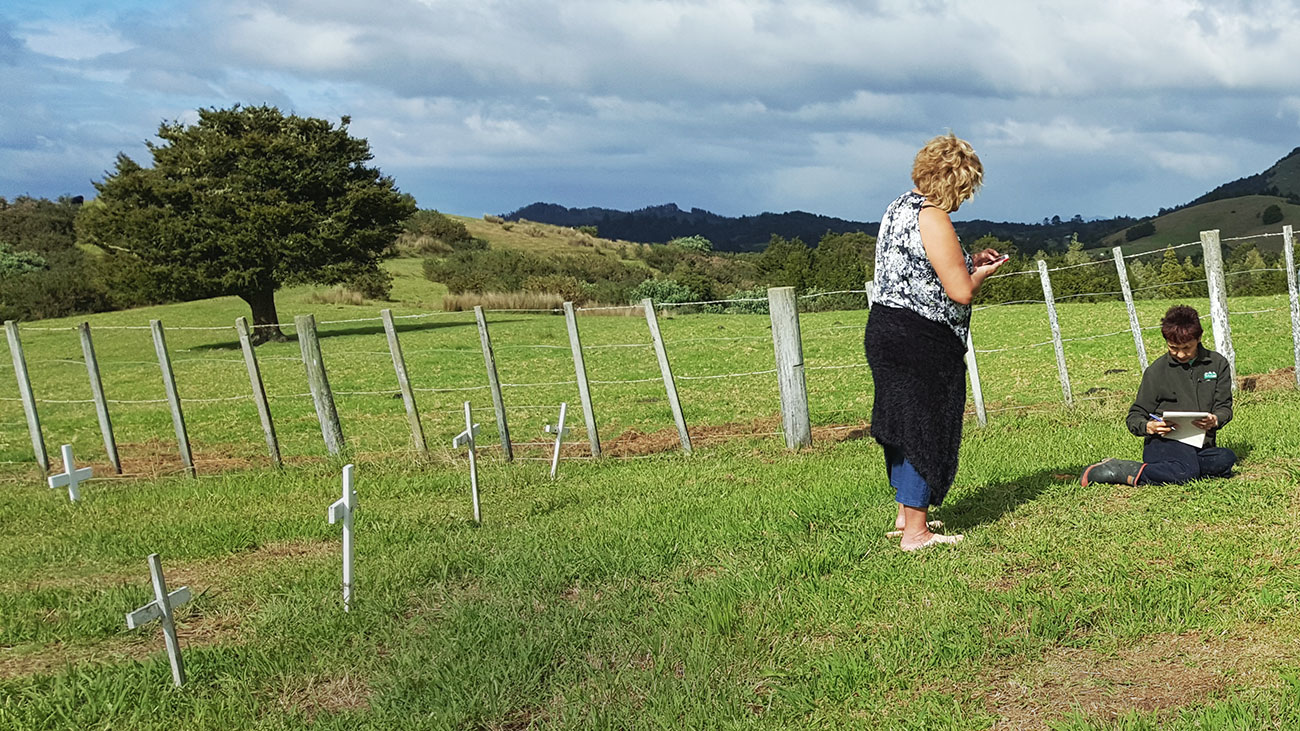
Recording grave marks directly in the field using Mobile Data Collection
GIS Cloud enabled us to create a project that will collate all names and grave markers of Te Orewai to the present. We wanted to provide access to an online database of names and burial grounds, to families and extended family looking for their ancestors, no matter where they live. GIS Cloud provided the software licences for our team to gather the information and set up a form to collect the data. This includes names, date of birth and death, location and the photo of the grave marker, because many of the grave markers deteriorate over time.
Delaraine and her team have finished data collection and were also “cleaning up” the data, to ensure all details are as accurate as they can be. They created the online database that whanau can access to know exactly where their family member or ancestor is buried, with the exact GPS location and other relevant data such as dates and photos.
The support from GIS Cloud has been great. Even though we have different time zones, GIS Cloud has been quick to respond to any queries, providing advice to make the process easier. None of us had experience in using GIS mapping tools, but there was no hardship with the support of the GIS Cloud team. We are very grateful for the opportunity to create a permanent record for the future, that our whanau can access anywhere, at any time.
Te Orewai Wahi Tapu project demonstrates an incredible application of GIS Cloud and Mobile Data Collection for the purpose of preserving an important part of heritage for Maori in New Zealand. We hope to see more from Delaraine and her team in the next two months when they will release their Wahi Tapu records for the public.
In the meantime, you can show them support by liking their project page on Facebook.



